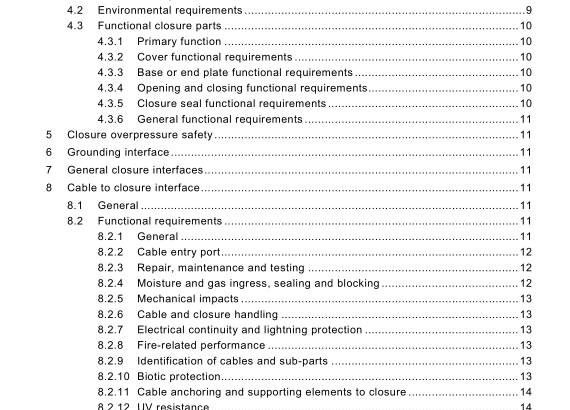IEC 61758-1:2008 pdf download – Fibre optic interconnecting devices and passive components – Interface standard for closures – Part 1: General and guidance
Environmental performance tests are carried out to suit the installed environment. Each has
an appropriate severity category listed in IEC 61 300 and IEC 61 753-1 :
• S: subterranean (underground);
• A: aerial;
• G: ground level;
• C: controlled (in building).
4.3 Functional closure parts
4.3.1 Primary function
The primary function of the closure is to protect the fibre and other functional parts and to provide quick access to all internal components and assemblies.
The primary functional parts of the closure are:
• covers;
• base or end plates;
• closing parts;
• seals for the base or end plates.
4.3.2 Cover functional requirements
The closure cover requires the following features:
• sealing feature;
• means of attachment .
4.3.3 Base or end plate functional requirements
The primary function of the base or end plate is cable attachment and sealing.
The closure base or end plate requires the following features:
• sealing feature;
• means of attachment;
• cable entry ports.
4.3.4 Opening and closing functional requirements
The opening and closing function provides access to internal members, adequate closing force and structural strength.
The closure cover to base fixing requires the following features:
• secure fixing;
• sealing feature.
4.3.5 Closure seal functional requirements
The function of these parts of the closure is to form a gas and liquid resistant seal.
4.3.6 General functional requirements
In addition to the above the following functions shall be provided, where required, in each closure:
• ability to attach other structural parts;
• ability to fit an air pressure valve.
5 Closure overpressure safety
Overpressure can build up in sealed closures due to temperature differentials over a period of time, or due to tightness testing of the seals after installation or incorrect installation techniques.
Care should be taken when opening a sealed closure.
Provisions shall be made that overpressure is exhausted when opening the closure prior to complete removal of the cover.
For all sealed closures used for air blown fibre cable applications, a preset overpressure release system is required.
6 Grounding interface
When required by local regulations, metallic parts of the closure shall have a provision for electrical grounding, primarily for safety. Additional parts can be used to provide an external grounding.
7 General closure interfaces
This standard defines interfaces of:
• cable to closure interface;
• FMS to closure interface;
• other parts to closure interface;
• closure to external interface.
8 Cable to closure interface
8.1 General
Functional requirements of the cable to closure interface shall maintain the mechanical,electrical and environmental characteristics of the cable when cable sheath is removed.
These interface specifications consider fibre types according to the IEC 60793-2 series and cable types in compliance with the IEC 60794-2 and IEC 60794-3 series.
8.2 Functional requirements
8.2.1 General
The interface requirements depend on the cable construction and environmental category.
The main function of the closure is to ensure the gas and water tightness of the fibre connections of two or more connected fibre optic cables. Furthermore the closure shall ensure maintenance of the mechanical continuity the cables had before being interrupted. Different cable elements like sheath and strain relief member shall be fixed to the closure. The interface between the cable and the closure as well as cable/closure installation technique shall be designed to minimize additional losses of the fibre optic link. Cable termination fittings are an integral part of the cable installation technique and shall be considered also.
8.2.2 Cable entry port Cable entry port is defined as the transition point from the fibre optic cable to the fibre optic cable termination. The cable entry port design depends on the cable type, in particular whether the cable sheath type is metallic or plastic. The dimensional correspondence between the cable and cable entry port diameter shall be defined according to the installation procedure and sealing technique
